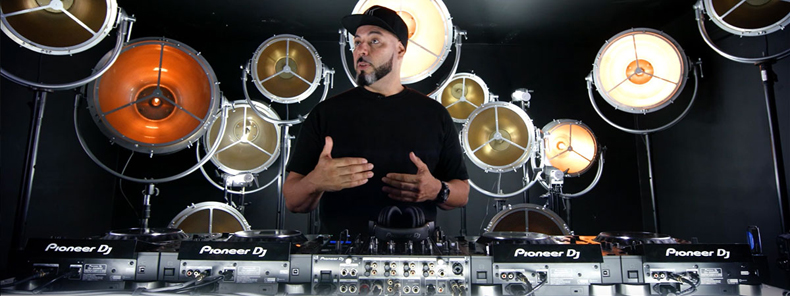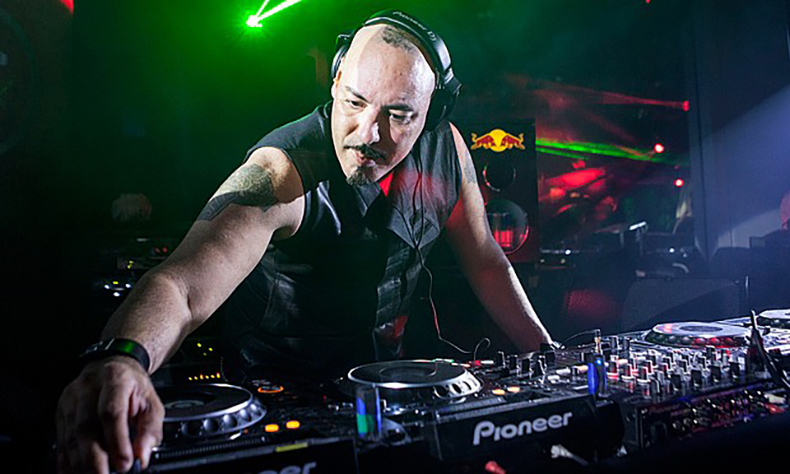Audio file: Roger Sanchez, Grammy-winning DJ
We speak to Grammy Award-winning DJ Roger Sanchez about building tracks in the studio and on the spot in a club, and get an idea of his own listening habits.

When Roger Sanchez tells us about his music taste, it really ought come as no surprise it's so varied. Even taking into account only his remixes, you couldn't really expect a man who has worked on tracks with artists diverse as Depeche Mode, Kylie Minogue, Garbage and Maroon 5 to be pigeonholed as a listener.
And we make particular mention of his remixes, because that's what earned him a Grammy Award in 2003 when he delivered his version of No Doubt's Hella Good. Throw in four Best House DJ crowns from the DJ Awards, and there are few people better placed to speak with What Hi-Fi? about creating and playing electronic dance music.
Below, Sanchez tells us about how he builds a track, the way he creates a bespoke live experience in a club, and why clarity and transparency are always king.
Highest resolution possible

What Hi-Fi?: What’s the writing and recording process like for you?
Roger Sanchez: I work predominantly with Logic and Ableton Live, and it depends where I get my idea from – I may get an idea from a melody line, I may get an idea from a lyric – but I predominantly start with percussion and drums. I lay down a simple beat to get a vibe going quickly, and I’ll do that in Ableton Live, for the simplicity of being able to drag-and-drop beats and samples and sounds, and being able to organise them very quickly.
Meanwhile they’re being rewired through an auxiliary channel in Logic, and then I’ll export them into Logic. Then I’ll begin to work on a melody line or a bass line, laying them over a simple beat that I’ve constructed. Then I’ll start to develop the layers of the track until I have a working rough.
That all depends whether it’s a full vocal project, or if it’s instrumental or maybe a bit of a vocal hook. If it’s a full vocal I might send it out to a writer, or I might write bits myself, then I’ll send the guide off to whichever vocalist I’m working with. If I get the chance to work with them actually in my studio then I’ll bring them in, but a lot the time nowadays things are done remotely, just because of time restraints.
The latest hi-fi, home cinema and tech news, reviews, buying advice and deals, direct to your inbox.
WHF: So if the vocal is done remotely, do you give them instruction about how you want the track recorded?
RS: It depends on what the goal of the track is. For instance, if there’s a vocal I may want to sound like it’s coming through a telephone for whatever reason, generally it’s not as important - the clarity of it - because I’m going to distort it anyway. But generally I want the cleanest recording possible.
I ask them which microphones they prefer to use, then get an idea of the colouration of the type of vocal I’m trying to get back. But my primary thing is to say: “What kind of microphone works best for you?” And I want it to be in the highest resolution I can possibly have, and something dry.
Maybe if they’re doing comp background vocal then I can say I want stereo comp background vocal, but I want it to be dry and I want the leads and the harmonies all on separate stems. That way I can reorganise them to get a particular flavour in the stack – some stacks you might want a little more of the higher vocal to be more prominent, and some stacks you may want the middle or the bottom end of the vocal to be more prominent. That’s why I prefer to have individual stems rather than a comp backing vocal, but it all depends on how the artist works.
WHF: What’s the most important aspect of a mix for you?
RS: It all depends on the track. I try to approach everything in a very bespoke manner. There are some records that are much more dependent on bottom end and rhythm, and are a lot more percussive. There are some tracks that may be more melodic, where maybe the drums aren’t as predominant on a track, it may be more the chords or whatever it is.
So I leave the prominence of whatever it is according to the type of track that it is. However, what I’ll always say when I’m working with a vocal: clarity and presence of the vocal has to be the intention of a track, always.
There may be some times that you want to have an unintelligible vocal, to provide a melodic note, so it acts as an instrument, maybe you don’t want them to hear it but to have an intonation of what it is that that vocal is saying, but generally... my vocals, I’m concerned that they’re clear, they’re intelligible, and always very present and very understandable.
Radio against the club
WHF: And do you mix tracks differently for different settings or systems?
RS: Radio is always a bit different to a club setting. If I’m doing a track that’s going on radio, I’ll do a mix where the vocals are bumped up a little bit louder. Most people who listen to radio are listening to it in their cars or at home, and it's not always the most high fidelity of sound systems, so you want to make sure the most predominant elements, which will be the vocal and melody lines, are more audible.
In a club, the bottom end’s going to be most important thing. So you always want to make sure, when you’re mixing for clubs, that your bass and your drums and everything that drives it have the clarity and power. Everything is important but, if you’re going to lean towards anything, you lean more towards the bottom end and the percussive end for the club side. For the radio it’s almost an inversion.
WHF: So when you’re DJing, at a club or a festival, what do you like to use?
RS: When I’m DJing, generally I’m playing out of four Pioneer CDJ Nexus 2. I also do vinyl sets – I’m working with a company called Vertere, who make high fidelity turntables, not DJ turntables, so there’s a collaborative project I’m working on with them at the moment to see if we can come up with something. But in the current setup it's four CDJs at the same time, and I tend to like to build a mix live.
WHF: So do the CDJs allow you to build tracks more easily?
RS: The CDJ is a different animal to vinyl. First of all, it’s something that’s become more standard around the world – I actually use USB as opposed to actual CDs. When I’m playing, I’ll be introducing effects, loops, vocal tracks and remix them on the spot, almost as a production element.
So I’ll create maybe breakdowns that don’t exist on the track, basically creating moments in the night and to create a different version of maybe a classic house track. So it’ll be a version of a track you may have heard before but presented in a different way that makes it fresh. And also, because I’m doing it on the spot, it’s never exactly the same.
Transparency and clarity
WHF: What kit do you use at home?
RS: At home, I have a Bang & Olufsen system, but when I’m listening to more electronic house music then I’ll tend to be in my studio. The speakers designed for my studio are incredibly true. For me, personally, that’s most important.
For listening pleasure, some people may want to have a little more bottom end bumped up, they might want that crazy bottom end that makes you feel like you’re in a club. But for me, personally, I like to hear things as they’ve been done, without distortion. If I want a little bit of bottom end, if I want that feel then cool, but generally I tend to like transparency and clarity.
WHF: And what kind of music do you listen to?
RS: Every day I listen from one end of the spectrum to the other. I’ll be listening to Kendrick Lamar, James Blake, Bonobo, then I’ll listen to Art Blakey. I like to listen to things that chill me out a lot more when I’m on the road.
Or if I want to put myself in a certain mind state, especially if I’m going to be creating afterwards, then I’ll listen to different vibes. I may listen to a guy like Manu Chao, which is very kind of world beat, something with interesting, quirky arrangements; then I might listen to Linkin Park or something like that. So my tastes are quite varied, but it’s always about the mood it's creating.
Buy Roger Sanchez on Amazon
Catch Roger Sanchez at Boardmasters this August
What Hi-Fi?, founded in 1976, is the world's leading independent guide to buying and owning hi-fi and home entertainment products. Our comprehensive tests help you buy the very best for your money, with our advice sections giving you step-by-step information on how to get even more from your music and movies. Everything is tested by our dedicated team of in-house reviewers in our custom-built test rooms in London, Reading and Bath. Our coveted five-star rating and Awards are recognised all over the world as the ultimate seal of approval, so you can buy with absolute confidence.


